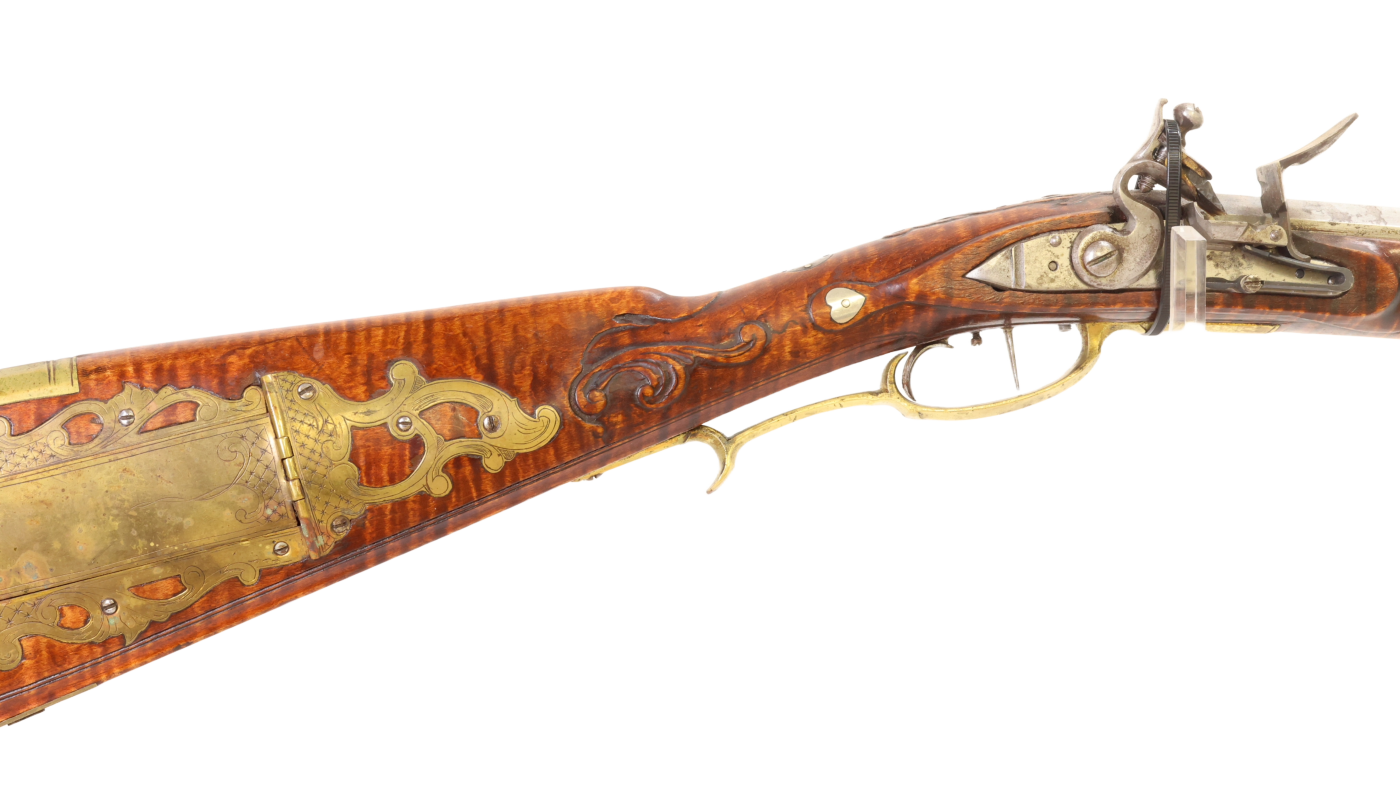Artistry Meets Necessity with Pennsylvania Long Rifles

Artistry Meets Necessity with Pennsylvania Long Rifles
Edited by Christian Answini | Senior Fine Art Specialist
The Pennsylvania long rifle was born of necessity in the early 1700s. What began as a practical tool for survival and sustenance in the American frontier has evolved into a coveted showpiece that blurs the line between functional firearm and fine art. Today, these rifles are not just historical artifacts; they're the centerpieces of high-end collections and sophisticated interior designs. But what is it about these exquisite creations that has captured the hearts of collectors, designers, and history enthusiasts alike?
To understand the allure of the modern Pennsylvania long rifle, we must first delve into its rich history. As German immigrants settled in southeastern Pennsylvania in the early 18th century, they brought with them the skills and knowledge to address the challenges of life in the New World. The need for accurate, long-range firearms for both hunting and defense led to the development of a uniquely American firearm. By blending elements of the German Jäger rifle with the English fowling piece, these skilled craftsmen created a long, sleek, and highly accurate flintlock rifle that would become known as the Pennsylvania long rifle.
.png)
These early gunsmiths were more than just weaponsmiths; they were artists in their own right. Many were skilled woodworkers and blacksmiths, which led to the creation of increasingly ornate and personalized firearms. Elaborate brass and German silver patch boxes, intricate engravings, and beautiful wood carvings became hallmarks of these rifles. As the years progressed, so too did the technology, with the invention of the metallic percussion cap in the 1830s slowly replacing the flintlock ignition system. Yet, the core design and artistic elements of the Pennsylvania long rifle remained largely unchanged.
The popularity of these rifles grew beyond their practical applications. Shooting matches and contests became common social events, with competitors eager to show off their prized firearms. This competitive spirit drove further customization and embellishment. Gunsmiths began sourcing the finest tiger stripe maple, walnut, and cherry for their stocks. They fitted handmade sights and adorned their creations with ever more elegant brass and metalwork. The brass patch box, typically found in the side of the butt stock, became a canvas for intricate designs and engravings. Some innovative craftsmen even developed sliding dovetail-type wood patch box lids, adding both functionality and artistry to their designs.
As the 19th century progressed and metallic cartridges became the norm, the popularity of muzzleloaders waned. However, the Pennsylvania long rifle was far from forgotten. Books, stories, and eventually television rekindled interest in these iconic firearms. Tales of American legends like Lewis and Clark, Davy Crockett with his "Old Betsy," and Daniel Boone's famous "Tick Licker" captured the public imagination, romanticizing these old-school arms and the era they represented.
This renewed interest sparked a renaissance in the world of Pennsylvania long rifles. Modern artisan gunsmiths began crafting these firearms once again, not out of necessity, but as an artistic pursuit producing some of the most elegant and functional long rifles ever seen. Craftsmen for over 200 years have been elevating the Pennsylvania long rifle to artistic heights, using it as a canvas to showcase their skills and creativity.
Many contemporary gunsmiths are pushing the boundaries of traditional designs while still honoring the rifle's heritage. Some incorporate intricate wildlife scenes or historical motifs into their work, creating rifles that tell a story through their decorative elements. Others experiment with non-traditional materials or modern design influences, resulting in pieces that bridge the gap between historical artifact and contemporary art.
What makes these modern interpretations so appealing is their ability to connect us with history while showcasing the pinnacle of current craftsmanship. Many gunsmiths still employ traditional hand tools and methods, preserving centuries-old skills that might otherwise be lost to time. Some specialize in creating faithful reproductions of specific 18th and 19th-century rifles, meticulously researching and replicating every detail down to the type of nails used in the original.
_(1)_1.png)
The appeal of the Pennsylvania long rifle extends beyond the world of firearm collectors. Interior designers have embraced these pieces as statement elements in high-end homes and lodges. Whether mounted horizontally above a fireplace or displayed vertically as part of a larger historical vignette, these rifles command attention in any room. Their warm wood tones and gleaming brass or silver accents complement both rustic and contemporary interiors, adding a touch of history and craftsmanship to any space.
For those looking to incorporate a Pennsylvania long rifle into their decor, consider pairing it with other period-appropriate items. A powder horn, antique map, or early American furniture piece can create a cohesive historical display. The key is to let the rifle be the star of the show while supporting it with complementary elements that enhance its historical context.
If you're considering adding a Pennsylvania long rifle to your collection or home decor, there are several factors to keep in mind. First, familiarize yourself with the different regional styles and notable craftsmen, both historical and contemporary. The workmanship quality in both wood and metal components is crucial – look for clean lines, smooth finishes, and precise fit between parts. For antique pieces, provenance can significantly increase a rifle's value, so a well-documented history is highly desirable.
For those eager to explore this fascinating world, our upcoming October 29th firearms and October 30th Accessories auctions presents an unparalleled opportunity to acquire a piece of this uniquely American legacy










